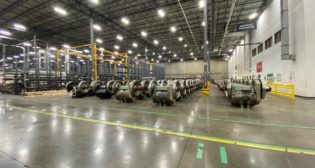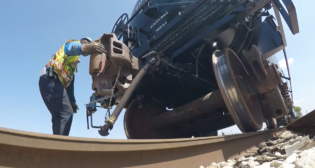
Tank car building drives a growing freight car market
Written by William C. Vantuono, Editor-in-ChiefAccording to the Energy Information Administration (EIA), U.S. total crude oil production averaged 6.4 million barrels per day in 2012, an increase of 0.8 million from the previous year. Projected domestic crude oil production will increase to 7.3 million barrels per day this year and 7.9 million barrels per day in 2014, which would mark the highest annual average level of domestic production since 1998.
The railroads have been playing an increasing important role in moving all this “black gold,” which requires lots of equipment. A close look at freight car building metrics shows that the carbuilders with tank cars (“the most diverse of all freight car designs and the most challenging to design and build,” according to one manufacturer) in their portfolios—Greenbrier, Trinity, Union Tank Car, American Railcar Industries—have more than enough work to keep production lines humming.
As of late April, tank cars continued to dominate the freight car building market, accounting for 81% of total orders in the first quarter of this year—19,267 cars out of 23,901, according to the Railway Supply Institute’s American Railway Car Institute (ARCI) Committee. “We’ve never seen numbers like this before,” says RSI Executive Director Tom Simpson.
Overall, 11,952 cars of all types were delivered in the first quarter, and the backlog of cars ordered but undelivered swelled to 71,704—a figure no doubt skewed by the run on tank cars. “Based on current production run rates of approximately 24,400 per year, we estimate the industry has 2.5 years of tank backlog visibility, suggesting the OEMs are quoting delivery times into 2015,” KeyBanc Capital Markets analysts Steve Barger and Tejas Patel note. By contrast, the non-tank-car backlog stands at 10,411, “which at current production run rates is less than two quarters of production visibility, although from a total capacity standpoint, it is less than one quarter’s worth of production.”
The KeyBanc analysts stress that “activity remains characterized by an extreme weighting toward tank cars, which we think is reflective of both the explosive growth in shale oil production and the generally weak volume environment for other commodity types. Specific to tank cars, 19,267 orders is highest number since ARCI started to provide data by car type in first-quarter 2007, and it exceeded the recent peak of 16,318 in first-quarter 2011. Over the past nine quarters, tank car orders have averaged 9,795 per quarter vs. the non-tank average of 9,030.”
Putting these orders into a fleet-makeup context shows just how extreme the weighting toward tank cars is: Tank cars account for roughly 20% of the industry wide railcar fleet. All other car types combined account for 80% of the fleet.
Crude oil and gas shale development is behind the tank car building boom, a point not lost on analysts. A recent Wall Street Transcript headline declared that oil and gas shale will benefit western railroads, and their shareholders, significantly. Union Pacific, says one analyst, “has the ability to grow earnings per share 15% a year going forward,” based on crude oil and gas shale business growth.
Said another analyst: “One good thing about the western part of the U.S. is that it’s growing very fast thanks to oil and gas shale development. Volume should continue to go up. We also believe that Union Pacific and BNSF have a very good cost structure, and they have been able to increase the price they charge for their volume. If you look at the past five years, UP increased its pricing by about 5% a year, which is very good in this low-inflation environment. We also think UP is very shareholder-conscious: UP repurchased close to $6 billion of shares in the last few years. If you combine the volume increases, margin improvements, and the pricing gains with returning money to shareholders, we think UP can grow earnings per share at about 12% to 15% a year going forward.”
Economic Planning Associates, in its most recent freight car building report, is also bullish on tank cars: “The most dynamic element in the long-term railcar environment will be tank cars to transport ever increasing volumes of oil and petroleum products. Though there was an expansion in demand for a variety of covered hoppers, mill gondolas, and Class F flat cars in the fourth quarter of 2012, tank cars remain the dominant force in overall equipment demand. In the second quarter of last year, tank cars accounted for 83.5% of total orders. Even with improvements among a variety of other railcars, tank car orders comprised 58.3% of total orders in the third quarter and 61.8% of the orders in the fourth quarter. It is quite obvious that the growth in tank car demand is centered in the movement of crude oil, particularly from the Bakken Shale Formation in the Dakotas.”
The market beyond tank cars
Overall, EPA expects total car orders this year to top off just above 50,000, down from 2012’s 58,900, then rebound strongly in 2014 and experience steady growth through 2018. “While we are pleasantly surprised by the modest expansion in demand for other car types, we remain cautious,” EPA said. “We are concerned about the underwhelming growth of the economy as manufacturers, oil and gas producers, and coal companies struggle with the increasing number of government regulations. GDP growth slipped in the fourth quarter. Hopefully, our economy will embark on a stronger path of growth that will improve railroad traffic, revenue, and investments, leading to continued growth in railcar demand.
“Assuming no further jolts to our economy, we look for a stabilization in demand for most car types with the exceptions of small-cube covered hoppers and coal cars. After strong deliveries in 2011 and the first half of 2012, demand for these hoppers weakened considerably in the second half. As a result, our estimate of an easing in assemblies of small-cube equipment from 13,781 units last year to 5,000 units in 2013, as well as the pronounced weakening in coal car demand, will serve to drop total railcar deliveries from 58,900 cars last year to 50,500 cars in 2013.”
“Replacement pressures and technological advances as well as legislative measures will play a role in promoting the demand for a variety of railcars,” EPA said. “Construction activities are expected to continue to advance, which should support movements of aggregates and structural steel products. Continued expansion in demand for petroleum products, chemicals, and food and beverages will prop up the haulings of liquid products, in addition to the demand for tank cars. Stricter air emission standards will promote use of lower sulphur western coal, which should lead to limited replacements of older steel bodied coal cars. At the same time, eastern coal fleet requirements will stimulate some demand for technologically advanced steel and hybrid coal cars. Growing worldwide nutritional needs and expanding exports will pressure the current grain service cars as we proceed through the longer term while long neglected segments such as equipment to haul waste, aggregates, and limestone show signs of revival.”



